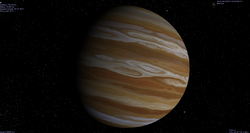Astronomy:Upsilon Andromedae e
 An artist's impression of Ups And e | |
| Discovery | |
|---|---|
| Discovered by | Curiel et al. |
| Discovery site | Baja California |
| Discovery date | November 22, 2010 (announced) December 2, 2010 (published) |
| Doppler spectroscopy | |
| Orbital characteristics | |
| astron|astron|helion}} | 5.2738 ± 0.0029 AU (788.95 ± 0.43 million km) |
| astron|astron|helion}} | 5.2175 ± 0.003 AU (780.53 ± 0.45 million km) |
| 5.2456 ± 0.00067 AU (784.731 ± 0.100 million km)[1] | |
| Eccentricity | 0.0055±0.0004[2] |
| Orbital period | 3,848.86±0.74[2] d ~10.53946[2] y |
| 367.3 ± 2.3[1] | |
| Star | Upsilon Andromedae |
Upsilon Andromedae e is the proposed outermost extrasolar planet orbiting the star Upsilon Andromedae in the constellation of Andromeda. If it exists, this planet would be one of the most Jupiter-like exoplanets found in terms of mass and semi-major axis. However, subsequent studies have found that the apparent planetary signal is more likely to be an instrumental artifact.[3][4]
Discovery
This planet was discovered on November 22, 2010, but the discovery paper was not released until December 2.[1] It was the fourth time in 2010 that a fourth planet has been discovered in a planetary system, the others being Gliese 876 e, HD 10180 e, and HR 8799 e; in no earlier year during the exoplanet era had more than one fourth planet been discovered.
Subsequent studies in 2011 and 2014, while finding some evidence for a fourth planet, found large inconsistencies in the estimated orbital period of Upsilon Andromedae e depending on what dataset was used,[5] suggesting that the apparent planetary signal is more likely to be an instrumental artifact.[3][4]
Astronomers initially thought that a fourth planet in this system could not exist because it would have made the planetary system unstable and would have been ejected.[6] But in 2007, an island region of stability was reported where a fourth planet could exist.[7]
Characteristics
If it exists, Upsilon Andromedae e would have a minimum mass slightly greater than Jupiter's and orbit at a similar distance as Jupiter from the Sun, at 5.2456 astronomical unit|AU compared to 5.2043 AU for Jupiter. Although only the minimum mass is determined since inclination is not yet known, its true mass might be much greater. It would take over a decade to orbit the star. At an eccentricity of 0.00536, the planet's orbit would be more circular than that of any of the planets in the Solar System.[1]
See also
- HIP 11915 b – another Jupiter analog discovered in 2015
References
- ↑ 1.0 1.1 1.2 1.3 Curiel, S. et al. (2011). "A fourth planet orbiting υ Andromedae". Astronomy & Astrophysics 525: A78. doi:10.1051/0004-6361/201015693. Bibcode: 2011A&A...525A..78C. http://www.aanda.org/index.php?option=com_article&access=standard&Itemid=129&url=/articles/aa/abs/2011/01/aa15693-10/aa15693-10.html.
- ↑ 2.0 2.1 2.2 Ligi, R. et al. (2012). "A new interferometric study of four exoplanet host stars : θ Cygni, 14 Andromedae, υ Andromedae and 42 Draconis". Astronomy & Astrophysics 545: A5. doi:10.1051/0004-6361/201219467. Bibcode: 2012A&A...545A...5L. http://www.aanda.org/index.php?option=com_article&access=doi&doi=10.1051/0004-6361/201219467&Itemid=129.
- ↑ 3.0 3.1 McArthur, Barbara E. (2014). "Astrometry, Radial Velocity, and Photometry: The HD 128311 System Remixed with Data from HST, HET, and APT". The Astrophysical Journal 795 (1): 41. doi:10.1088/0004-637X/795/1/41. Bibcode: 2014ApJ...795...41M.
- ↑ 4.0 4.1 Deitrick, R. et al. (January 2015). "The Three-dimensional Architecture of the υ Andromedae Planetary System". The Astrophysical Journal 798 (1): 46. doi:10.1088/0004-637X/798/1/46. Bibcode: 2015ApJ...798...46D.
- ↑ Tuomi, M.; Pinfield, D.; Jones, H. R. A. (2014). "Application of Bayesian model inadequacy criterion for multiple data sets to radial velocity models of exoplanet systems". Astronomy & Astrophysics 532: A116. doi:10.1051/0004-6361/201117278. Bibcode: 2011A&A...532A.116T.
- ↑ Ford, Eric B. et al. (2005). "Planet-planet scattering in the upsilon Andromedae system". Nature 434 (7035): 873–876. doi:10.1038/nature03427. PMID 15829958. Bibcode: 2005Natur.434..873F.
- ↑ Rory Barnes; Richard Greenberg (2008). "Extrasolar planet interactions". Proceedings of the International Astronomical Union 3: 469–478. doi:10.1017/S1743921308016980. Bibcode: 2008IAUS..249..469B.

